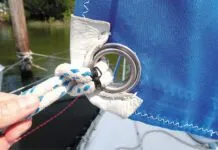Spinnaker Blocks
Ive been trying to rig my Catalina 22 for a spinnaker and generally upgrade the rigging. I have not been able to get any answers as to what strength of block I need for the spinnaker halyard. I would think that the block at the masthead would take a lot of strain. Has PS done an article on this? Is there a rule of thumb such as so many square feet of spinnaker needs such and such working load on a block? How about the block at the foot of the mast used to lead the halyard aft?
Also, I am adding an adjustable backstay with a block at the end of the wire from the top of the mast. Through this block I will run another wire, one side of which will attach to the transom, the other to set of blocks which will attach to the transom. This is similar to example #2 in the 2000 Harken catalog. How strong do the blocks need to be?
Have you done any articles on what type of lines to use for halyards, sheets, etc.?
John Flato
Houston, Texas
The top of the mast is no place to have trouble. Youre right that spinnakers place heavy loads on the halyard block, especially if you fly a spinnaker in strong winds. Because the block swivels furiously as the spinnaker moves both horizontally and vertically, it can place some nasty side loads on the block. Thats why ball bearing blocks (which prefer a nice straight load) arent always selected for spinnaker halyards. Wed suggest an aluminum-sheaved, swivel head block with a plain bearing. Perhaps a Schaefer 505-05 or Lewmar Size 0, part #19901700. If you can’t resist a ball-bearing block, Torlon balls are stronger than Delrin, but may be overkill in your application. A third choice is Harkens carbon-filled balls, as in its #001 single block. Same goes for the blocks on the backstay.
Perhaps you overlooked it, but the Harken catalog has all the information you need to determine block size, including a page of Loading Formulas.
We have done many reports on line. Probably the best all-round buy for halyards is New England Ropes Sta-Set.
Wet Deck
We recently took possession of a beautiful 1988 Pearson 31. At the time of survey it was found to have some deck moisture present, primarily around the stanchion bases. There is no evidence of delamination. Ive since re-bedded the deck hardware and stanchion bases to keep additional moisture out but I want to try and remove the existing moisture. Im considering once again removing the bases, shrink wrapping the boat for winter lay-up, installing a dehumidifier and letting the core dry naturally, as well as drilling small holes in the underside of the deck from inside the boat to also let the core air out over time. Have you any opinions on this process? Or perhaps additional methods or recommendations?
Ralph Bibbus
Via email
We seriously doubt that a dehumidifier will remove much moisture from the core…unless you remove a lot of the skin…more than a few small drill holes. But what the heck, it can’t hurt. Come spring inject epoxy into the suspected areas through those small drill holes. Wed get the Gougeon Brothers WEST SYSTEM brochure on how to do this. You can call them in Michigan at 517/684-7286 or www.westsystem.com.
Radar Current Draw
About your last radar article, how much do these 2 kW radars draw from the 12-volt battery? Secondly, what gauge cable is used from the radar head to the battery?
Willy Albanes
Huntsville, Alabama
Recreational radar units draw between about 2 amps (like the JRC 1000 LCD) to about 4 amps for a 48-mile radar. This is quite a bit; most units have a standby mode where power consumption is reduced. The size of wire depends on the distance between the battery bank and the unit. The longer the distance, the larger diameter wire should be used. For example, to keep voltage drop at 3% (desirable), a 5-amp current running 15 feet should be in wire at least #16 gauge. For 25 feet, it should be #12 gauge and at 40 feet #10 gauge. Bigger is better.



































